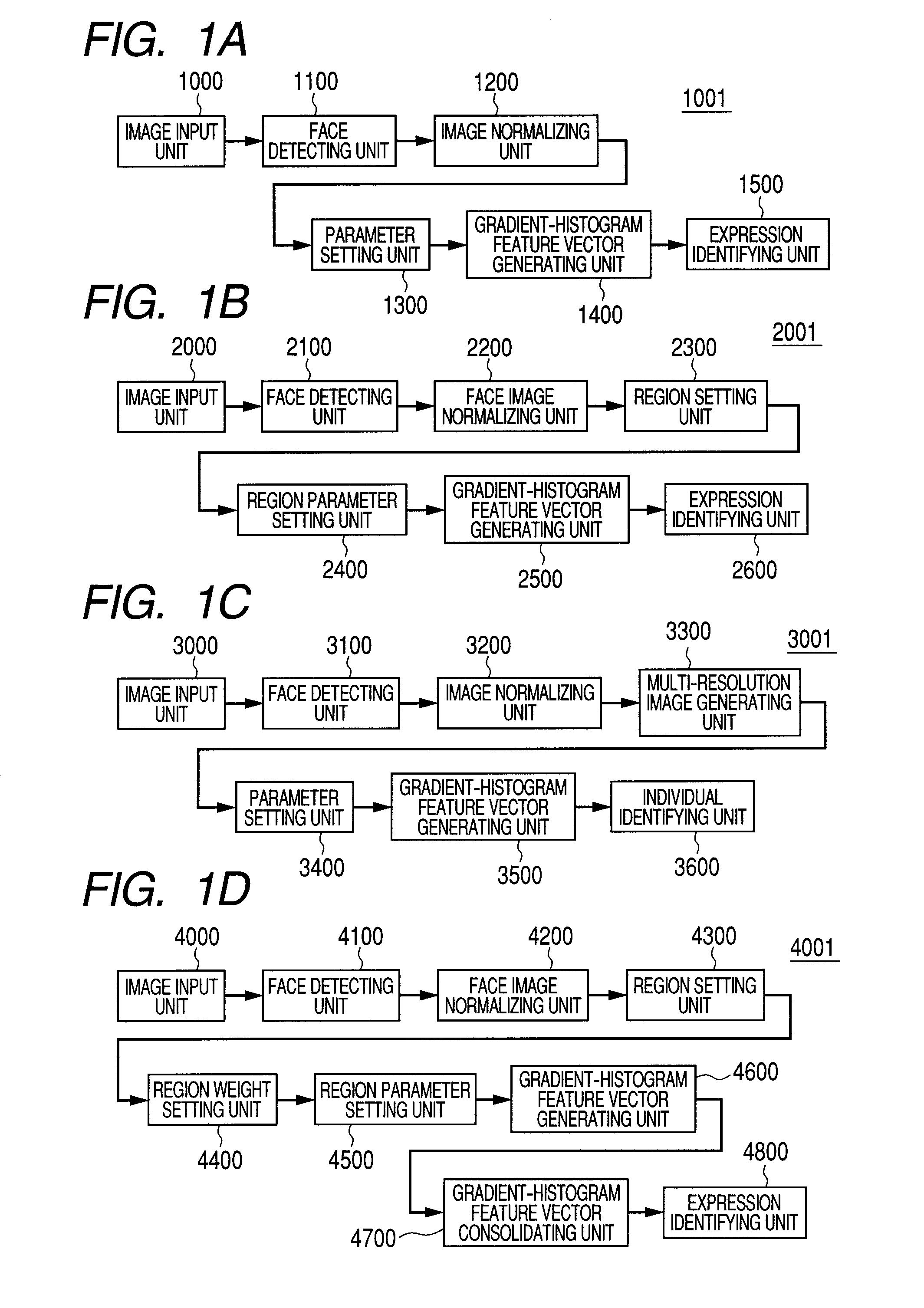Image recognition apparatus for identifying facial expression or individual, and method for the same
a facial expression or individual image recognition and image recognition technology, applied in the field of image recognition apparatus and imaging apparatus, can solve the problems of inability to set appropriate gradient histogram parameters according to the properties of target objects and categories, and inability to accurately identify facial expressions or individuals, etc., to achieve high precision
- Summary
- Abstract
- Description
- Claims
- Application Information
AI Technical Summary
Benefits of technology
Problems solved by technology
Method used
Image
Examples
first embodiment
[0038]The first embodiment describes an example of setting gradient histogram parameters based on face size. FIG. 1A illustrates an exemplary functional configuration of an image recognition apparatus 1001 according to the first embodiment. In FIG. 1A, the image recognition apparatus 1001 includes an image input unit 1000, a face detecting unit 1100, an image normalizing unit 1200, a parameter setting unit 1300, a gradient-histogram feature vector generating unit 1400, and an expression identifying unit 1500. The present embodiment discusses processing for recognizing a facial expression.
[0039]The image input unit 1000 inputs image data that results from passing through a light-collecting element such as a lens, an imaging element for converting light to an electric signal, such as CMOS and CCD, and an AD converter for converting an analog signal to a digital signal. Image data input to the image input unit 1000 also has been converted to image data of a low resolution through thinn...
second embodiment
[0100]The second embodiment of the invention will be described below. The second embodiment shows a case where parameters are varied from one facial region to another.
[0101]FIG. 1B is a block diagram illustrating an exemplary functional configuration of an image recognition apparatus 2001 according to the second embodiment.
[0102]In FIG. 1B, the image recognition apparatus 2001 includes an image input unit 2000, a face detecting unit 2100, a face image normalizing unit 2200, a region setting unit 2300, a region parameter setting unit 2400, a gradient-histogram feature vector generating unit 2500, and an expression identifying unit 2600. As the image input unit 2000 and the face detecting unit 2100 are similar to the image input unit 1000 and the face detecting unit 1100 of FIG. 1A described in the first embodiment, their descriptions are omitted.
[0103]The face image normalizing unit 2200 performs image clipping and affine transformation on a face 301 detected by the face detecting un...
third embodiment
[0119]The third embodiment of the invention will be described. The third embodiment illustrates identification of an individual using multi-resolution images.
[0120]FIG. 1C is a block diagram illustrating an exemplary functional configuration of an image recognition apparatus 3001 according to the third embodiment.
[0121]In FIG. 1C, the image recognition apparatus 3001 includes an image input unit 3000, a face detecting unit 3100, a image normalizing unit 3200, a multi-resolution image generating unit 3300, a parameter setting unit 3400, a gradient-histogram feature vector generating unit 3500, and an individual identifying unit 3600.
[0122]As the image input unit 3000, the face detecting unit3100 and the image normalizing unit 3200 are similar to the image input unit 1000, the face detecting unit 1100 and the image normalizing unit 1200 of FIG. 1A described in the first embodiment, their descriptions are omitted. Also, the distance between eye centers Ew used by the image normalizing ...
PUM
 Login to View More
Login to View More Abstract
Description
Claims
Application Information
 Login to View More
Login to View More - R&D
- Intellectual Property
- Life Sciences
- Materials
- Tech Scout
- Unparalleled Data Quality
- Higher Quality Content
- 60% Fewer Hallucinations
Browse by: Latest US Patents, China's latest patents, Technical Efficacy Thesaurus, Application Domain, Technology Topic, Popular Technical Reports.
© 2025 PatSnap. All rights reserved.Legal|Privacy policy|Modern Slavery Act Transparency Statement|Sitemap|About US| Contact US: help@patsnap.com



